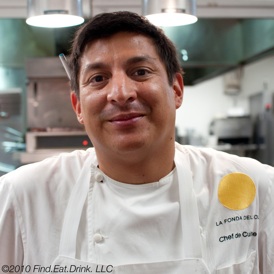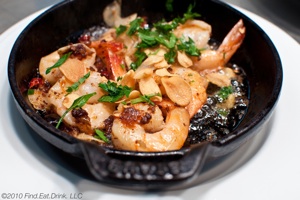Josh DeChellis, La Fonda Del Sol, New York, Spanish, Spain, Midtown East, Grand Central Station, Where to eat in New York, What to drink, where to buy spanish products, 10166

JOSH DECHELLIS
Chef Josh DeChellis started his career right at the top, working at Wolfgang Puck's famous Postrio. From there, he moved to Paris to work in two Michelin three-star restaurants: the famed L'Arpège and Lucas Carton. DeChellis joined chef Rocco DiSpirito at Union Pacific, and worked with notable chefs like David Bouley, Charlie Trotter and Jean-Georges Vongerichten, before opening his own restaurant, the Japanese Sumile. DeChellis followed up with BarFry, a modern American tempura bar. As executive chef at La Fonda del Sol, DeChellis is able to incorporate all the techniques from his varied training with a love of Spanish ingredients and flavors.
Q & A WITH CHEF JOSH DECHELLIS

Q. After years of working with Japanese cuisine at Sumile, are you able to incorporate any of the elements into your Spanish cooking?
A. For me, it’s always been more about sensibilities than a traditional genre. People always say ‘what’s the deal with that? How do you go from Japanese to Spanish, they’re so different?’ The truth is that both are really into their ingredients and into not screwing them up. By that I mean conventionally speaking for Spain, not so much with the modern cooking that is going on there. The Japanese tend to go through very traditional methods and put ingredients on a pedestal and praise it and the Spanish go through kind of the same steps. But then they drink a lot and smoke next to it!
It’s really great to take the intense focus of Japan and marry it with a real jovial sense of hospitality that Spaniards seem to live every day.

A. I’ve been dating Spain for a awhile. I first went to visit a friend back in like ’97 to Granada. It’s so different from the Basque country, where they are all proud of their food. But the Southerners tend to be proud where it’s like come on, come into my house and have dinner. Which has happened to me on more than one occasion down there. Up north in the Basque country, they are so proud of their food and then it’s like ‘ha! you’re not Basque and so you suck.’ Both proud, it just manifests itself differently.
Q. Where did you eat in Basque Country?
A. The place that talked to me the most was Mugaritz. It’s very personal and very moving. It was just my favorite food that I had in all of Spain, because he really took traditional things, or preparations, or ideas and presented them in very simple ways. Took things out of it that didn’t necessarily need to be there - clean beautiful dishes. It was remarkable. If you go, order the biggest menu they have to offer.
Q. Any off the beaten track places in San Sebastian?
A. I did like La Cuchara San Telmo, it’s very fun for tapas. Their stuff was on a revolving blackboard and they seemed pretty aggressive about changing their menu frequently.
Advice

Q. If we want to cook Spanish food, what are three specific Spanish ingredients we should have in our pantry?
A. Pimenton de la Vera:
Use it to snap your brain to Spain. Always consider adding a little of it. Take canned chickpeas, cook with a little garlic and spinach and dust with pimenton, add some olive oil... it’s so good! It’s a simple easy quick thing that you can make in like five minutes. By adding a little of the pimenton, it transports you to Spain immediately.
Fruity Spanish Olive Oil:
A lot of the olive oils that are on the market, seem to be coated for their big aggressive, what I call masculine, sort of flavors. Really, really peppery to the point where it almost chokes me a little. It burns the back of your throat and is intensely grassy. It’s a certain style of oil and they have their place somewhere, but I think they tend to be misused a lot. I recommend trying to find an arbequina olive oil made in the south. They tend to be fruitier than the ones produced in the north. There is one called hojiblanca and that’s a fruity one. Do some judicious shopping and when you get that nice fruity olive oil - finish off dishes with it. It makes a huge, huge difference.
Judion Beans:
Look on the label and you’ll see that they are harvested and put on the shelf with a ‘don’t use past this date’ stamp. You don’t want to use them past that. You know when you cook beans and some are soft and others are hard and falling apart and you’re all frustrated, well most of the time it’s because the beans have been in a warehouse for years and years, with no control over humidity or anything, so there is no way it’s going to cook as a consistent bean. But these guys are serious about their beans and because they date them, you know what you’re signing up for. Plus, they’re huge beans, so you’ll more than likely end up with a great pot of evenly cooked beautiful creamy beans and that’s a big deal.
Q. Where can we get these items?
A. Despana [in Soho, NY] or online, La Tienda [pimenton, olive oil, beans].
Q. Is there a cookbook, new or vintage, that you sometimes use or is like a bible to you?
A. Cooking By Hand by Paul Bertolli. The idea of detail oriented focus applied to old world cooking is wildly inspiring.
[Purchase on Amazon.com]
Q. Among your fellow chefs, whom do you admire and/or look to for advice?
A. Always loved the food from Zak Pelaccio because it is so personal and delicious. I’ve also always loved Paul Liebrandt’s cooking because it always teaches me things I do not know and he has a very sophisticated sensibility that I find successful.
Recommendations

FIND...
Q. Are there specific food markets/groceries that you love and what should we look for at them?
A. Well, let’s start in our backyard and talk about Whole Foods. Their middle isles are packed with unique things that have been very useful to me for problem solving. TVP burgers anyone?
Q. What are TVP burgers?
A. Textured Vegetable Protein burgers. We don’t look at stuff like that, us gastro-chasers. But, it’s crazy shit. It’s like this soy product that gets shot through a trademarked extruder and goes through a super hot environment and roasts and dries immediately and you end up with this light soy crackle of sorts. The nutritional value is stunning, when you compare the protein to carbohydrates. It’s the reverse of rice. It’s really versatile and different... and it’s at a supermarket.
[See details.]
EAT...
When not at your own restaurants, where do you love to dine in New York for:
Q. Off the beaten track places that you'd be excited to take an adventurous eater ?
A. Wa Jeal on Second Avenue, between 82nd and 83rd Streets. Su Wong, the service director at La Fonda just turned me onto a great Szechuan dish of shaved beef and tripe with peanuts and Szechuan peppercorns that was OUT OF CONTROL good.
[See details.]
Q. How about a place that won’t break the bank, but has killer food?
A. Rai Rai Ken for lunch and inexpensive eating. Shoyu ramen with extra pork and a Kirin. Out the door for $20.
[See details.]
Q. Where you going for Japanese food these days?
A. 15 East is the only place for sushi in my opinion. He is very skilled and you can tell he just loves it and it shows in the food. Each piece is garnished for the piece, some might be rubbed with lemon and salt or whatever. He uses tiny little flavor notes, specific for whatever he is serving. It’s funny how few sushi places do that.
[See details.]
Q. Places you loved on any of your visits around the world?
A. In Japan, Hotel Azuma on Sado Island does amazing seasonal food in the kaiseki style, they also have a onsen not to be missed.
[See details.]
DRINK...
Q. What interesting Spanish drinks have you discovered lately?
A. The world of sherry. Toro Albala Oloroso is awesome and not even produced in the Jerez territory. Hidalgo Palo Cortado is ridiculously unique, as is Lustau Tintilla de Rota. These sherries have inspired in a form of palate training and offer such unique additions to dishes or food and wine pairings.
[See details.]
Q. How about wines?
A. The wines from Rias Baixas are really just sort of up my alley. They are playful wines with integrity that pair well with light preparations of seafood. I really like Condes De Albarei Albarino.
[See details.]
October 18, 2010
WHO
Executive chef of La Fonda Del Sol, New York City.
WHY
He’s worked with the who’s who of chefs, including: Wolfgang Puck, David Bouley, Charlie Trotter, Jean-Georges Vongerichten, Rocco Dispirito; and in two Michelin three-star kitchens: the famed L'Arpège and Lucas Carton.

RECIPES

RECOMMENDATIONS
Josh Dechellis’ recommendations for where to eat and shop in New York, Spain, Japan, and advice on Spanish food products and Sherry.











Details of Josh Dechellis’ recommendations for where to eat and shop in New York, Spain, Japan, and advice on Spanish food products and Sherry.
RECOMMENDATIONS



LA FONDA DEL SOL - NEW YORK, NY

LA FONDA DEL SOL
Midtown East
Spanish
MetLife Building
44th Street/ Vanderbilt Avenue
New York, NY 10166 (view map)
T: 212 867 6767 (make a reservation)
Website:
Hours:
Mon - Fri: 11:30am - 3pm
Mon - Sat: 5pm - 10:30pm


















